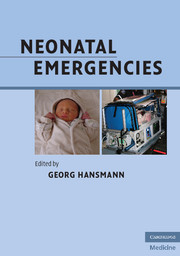Book contents
- Frontmatter
- Contents
- List of contributors
- Foreword (1)
- Foreword (2)
- Preface
- Acknowledgments
- Section 1 Organization of neonatal transport
- Section 2 Basics in cardiopulmonary resuscitation of newborn infants
- Basic equipment setup for initial neonatal care and resuscitation
- Drugs for neonatal emergencies
- Postnatal cardiopulmonary adaptation
- ABC Techniques and Procedures
- Sunctioning
- Stimulation, oxygen supplementation, bag-and-mask ventilation (M-PPV), pharyngeal/bi-nasal CPAP, and pharyngeal positive pressure ventilation
- Endotracheal intubation and gastric tube placement
- Laryngeal mask airway (LMA)
- Chest compressions
- Peripheral venous access
- Umbilical vein/artery catheterization (UVC, UAC)
- Central venous access (internal jugular vein)
- Intraosseous access
- Cord clamping
- Management of high-risk infants in the delivery room
- Monitoring in the delivery room and during neonatal transport
- Hygiene in the delivery room and during neonatal transport (infection control)
- When to call a pediatrician to the delivery room
- Checklist for the postnatal treatment of newborn infants
- Assigning individual duties in the delivery room
- Clinical assessment of the newborn infant
- Cardiopulmonary resuscitation of newborn infants at birth
- Volume therapy and sodium bicarbonate supplementation in preterm and term newborn infants
- Absolute and relative indications for neonatal transport and NICU admission
- Communication with mother and father
- Coordinating neonatal transport and patient sign-out to the NICU team
- Documentation and feedback after neonatal emergency transport
- Ethics in neonatal intensive care
- Perinatal images of preterm and term infants
- Mechanical ventilation of the neonate
- Questions for review (basics)
- References (Section 2)
- Section 3 Classic and rare scenarios in the neonatal period
- Section 4 Transport
- Section 5 Appendix
- Index
- Plate section
Communication with mother and father
from Section 2 - Basics in cardiopulmonary resuscitation of newborn infants
Published online by Cambridge University Press: 05 March 2012
- Frontmatter
- Contents
- List of contributors
- Foreword (1)
- Foreword (2)
- Preface
- Acknowledgments
- Section 1 Organization of neonatal transport
- Section 2 Basics in cardiopulmonary resuscitation of newborn infants
- Basic equipment setup for initial neonatal care and resuscitation
- Drugs for neonatal emergencies
- Postnatal cardiopulmonary adaptation
- ABC Techniques and Procedures
- Sunctioning
- Stimulation, oxygen supplementation, bag-and-mask ventilation (M-PPV), pharyngeal/bi-nasal CPAP, and pharyngeal positive pressure ventilation
- Endotracheal intubation and gastric tube placement
- Laryngeal mask airway (LMA)
- Chest compressions
- Peripheral venous access
- Umbilical vein/artery catheterization (UVC, UAC)
- Central venous access (internal jugular vein)
- Intraosseous access
- Cord clamping
- Management of high-risk infants in the delivery room
- Monitoring in the delivery room and during neonatal transport
- Hygiene in the delivery room and during neonatal transport (infection control)
- When to call a pediatrician to the delivery room
- Checklist for the postnatal treatment of newborn infants
- Assigning individual duties in the delivery room
- Clinical assessment of the newborn infant
- Cardiopulmonary resuscitation of newborn infants at birth
- Volume therapy and sodium bicarbonate supplementation in preterm and term newborn infants
- Absolute and relative indications for neonatal transport and NICU admission
- Communication with mother and father
- Coordinating neonatal transport and patient sign-out to the NICU team
- Documentation and feedback after neonatal emergency transport
- Ethics in neonatal intensive care
- Perinatal images of preterm and term infants
- Mechanical ventilation of the neonate
- Questions for review (basics)
- References (Section 2)
- Section 3 Classic and rare scenarios in the neonatal period
- Section 4 Transport
- Section 5 Appendix
- Index
- Plate section
Summary
The team that attends the delivery and performs the initial newborn care and eventually neonatal resuscitation should introduce themselves to the mother and father – given that the resuscitation unit is prepared and there is enough time prior to delivery. The same applies to the non-emergent inter-hospital transport of neonates. If postnatal transport is warranted, parents should be informed about the main reason for the transport team's arrival (e.g., postnatal tachypnea). Later, the need for the newborn's transfer to a tertiary NICU should be explained and at the same time the parents should be reasonably reassured.
A well-adapted newborn infant should not be transferred, but dried and warmly wrapped up and placed on the mother's chest – if there is any doubt, early assessment by a pediatrician and strict observation, which may include pulse oximetry, are required.
If basic measures have to be performed on the resuscitation unit (suctioning, stimulation, oxygen supplementation; e.g., after C–section), the father may be brought to the baby when spontaneous breathing/crying is established, and the newborn appears to be adapting well and appears stable. Let the father know what you are doing and how his child's transition into the ex utero world is going (i.e., in most cases, give reassurance).
Conversations with the parents may be difficult and demanding when the condition of the baby is critical. The physician performing the resuscitation/intensive care should mention and emphasize the critical condition of the newborn with sensitivity, empathy, and honesty.
- Type
- Chapter
- Information
- Neonatal Emergencies , pp. 181Publisher: Cambridge University PressPrint publication year: 2009



